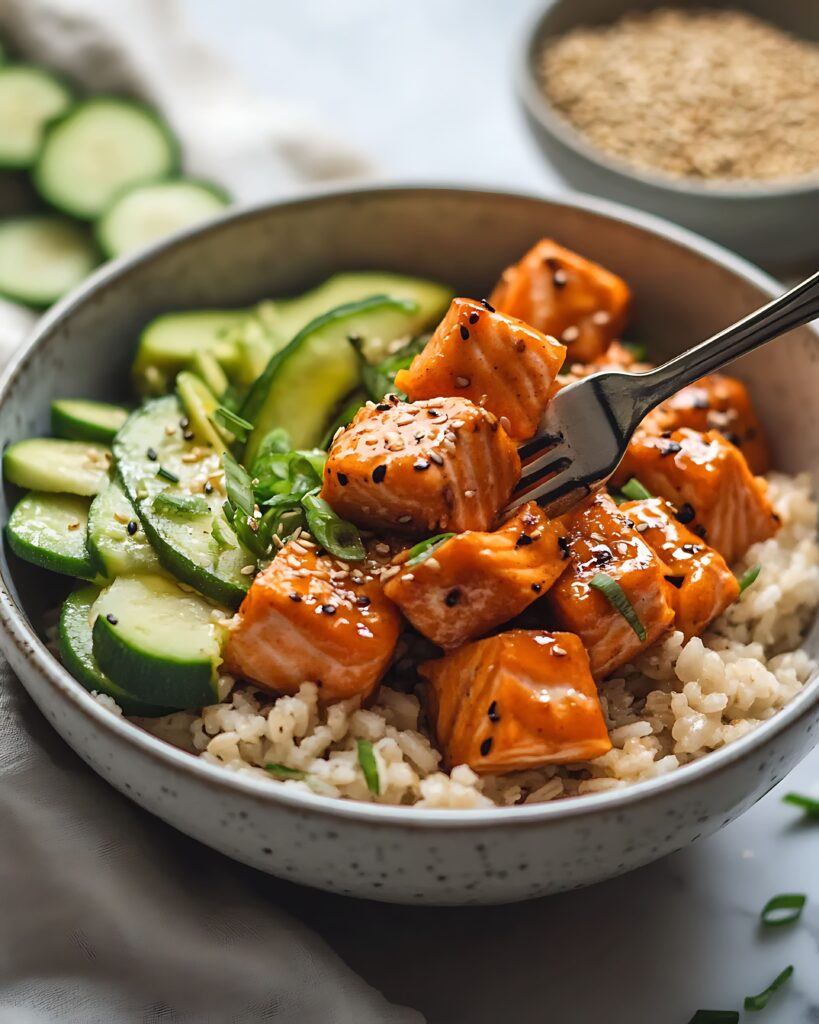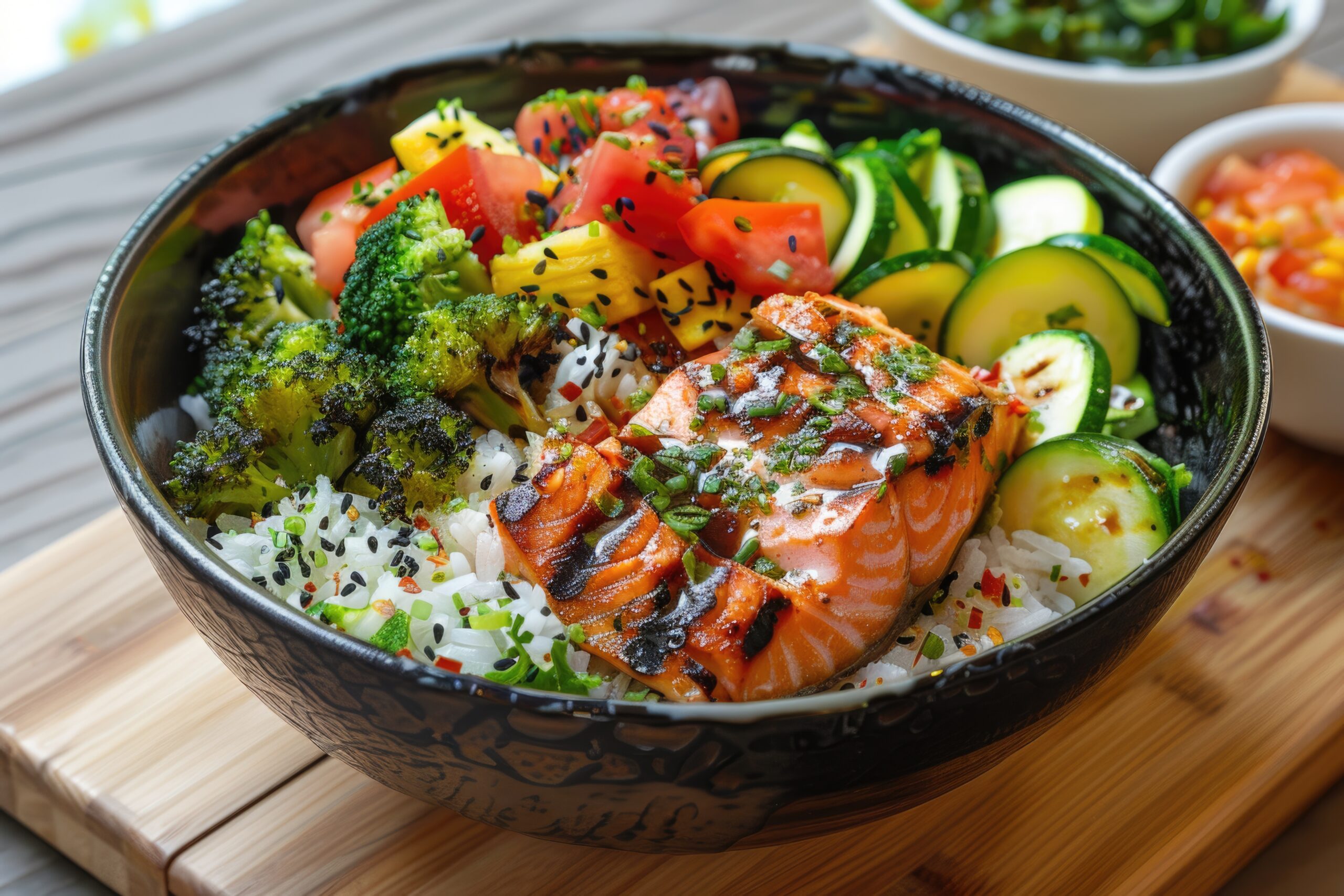When it comes to easy, delicious, and healthy meals, the salmon rice bowl is a true winner. Whether you’re a seasoned home cook or someone just learning their way around the kitchen, this dish offers a mix of flavors, textures, and nutrients that’s hard to beat. In this guide, we’ll walk through everything you need to know about creating a perfect salmon rice bowl—from selecting the right ingredients to tackling common problems. Let’s dive in!
Introduction to Salmon Rice Bowls
What is a Salmon Rice Bowl?
A salmon rice bowl is a fusion of fresh ingredients: tender salmon, perfectly cooked rice, and a medley of toppings. Think of it as a DIY meal that you can customize to your taste. Whether baked, grilled, or even cooked in an air fryer (learn how in Frozen Salmon in Air Fryer: The No-Fail Recipe You’ll Love), there are countless ways to enjoy this versatile dish.

Why Salmon Rice Bowls Are Gaining Popularity
You might have noticed salmon rice bowls popping up on restaurant menus, cooking blogs, and social media feeds. Why? They check all the boxes. They’re healthy, customizable, and surprisingly easy to prepare. Plus, with people focusing more on wholesome meals that don’t skimp on flavor, salmon rice bowls have become a go-to option.
👉 “A salmon rice bowl is like the Swiss army knife of meals—it’s versatile, reliable, and always satisfying.”
Ingredients for a Delicious Salmon Rice Bowl
Selecting the Perfect Salmon
Your salmon is the star of this dish, so choosing the right one is crucial. Freshness matters, and wild-caught salmon is often the best choice for both flavor and sustainability. If wild-caught isn’t available, go for high-quality farmed salmon—but avoid anything that smells overly fishy or has a dull color. Pro tip: Ask your fishmonger for sushi-grade salmon if you want to incorporate raw elements into your bowl.
To explore more creative ways to enjoy salmon, check out these Salmon Bowls You Need to Try for Balanced, Easy Meals
Quick Tip: If you’re on a budget, frozen salmon fillets are a great option. Just make sure to thaw them properly in the fridge overnight!
Types of Rice to Use for a Salmon Rice Bowl
When it comes to rice, there’s no one-size-fits-all answer. The best type depends on the flavor and texture you’re going for:
- Short-Grain Rice: Perfect for that sticky, authentic Japanese vibe. Think sushi rice.
- Brown Rice: A nuttier, fiber-rich option that’s great for a healthier twist.
- Jasmine or Basmati Rice: These aromatic varieties bring a lighter, fluffier texture to the bowl.
Still can’t decide? Go with short-grain rice—it’s a classic choice that pairs beautifully with salmon.
Essential Toppings and Garnishes
The toppings are where you can really let your creativity shine. Here are some must-haves:
- Vegetables: Cucumbers, avocado slices, shredded carrots, or edamame beans add freshness and crunch.
- Seaweed: Nori sheets or seaweed salad give a subtle umami kick.
- Pickled Veggies: A bit of pickled radish or ginger balances the richness of the salmon.
Feeling adventurous? Add a poached egg or kimchi for an extra layer of flavor.
Flavor-Enhancing Sauces and Seasonings
No salmon rice bowl is complete without a good drizzle of sauce. Some crowd favorites include:
- Soy Sauce: A classic choice for that salty, umami depth.
- Sriracha Mayo: A creamy, spicy option that’s super addictive.
- Ponzu Sauce: A tangy blend of citrus and soy that’s light and refreshing.
Seasonings like sesame seeds, furikake, or chopped green onions can take your bowl to the next level. Don’t forget to sprinkle a little love—because that’s what cooking is all about, right?
Why the Ingredients Matter
Every element in a salmon rice bowl plays a role. The salmon is your protein powerhouse, offering omega-3 fatty acids that are amazing for heart and brain health. Rice provides the comforting base, while toppings and sauces bring color, crunch, and complementary flavors. When combined, these ingredients create a balanced meal that’s as good for your taste buds as it is for your body.
Recap of the Essentials
Before moving on to the next step, let’s make sure you have everything you need:
- Fresh or frozen salmon fillets
- Your choice of rice (short-grain, brown, jasmine, etc.)
- A variety of fresh and pickled vegetables
- A flavorful sauce or two
- Optional: Eggs, seaweed, sesame seeds, or furikake
Ready? In the next section, we’ll dive into the nitty-gritty of how to bring all these ingredients together. Stay tuned!
Step-by-Step Guide to Preparing a Salmon Rice Bowl
So, you’ve gathered all your ingredients. Now, let’s break down the process of making a salmon rice bowl step by step. Don’t worry—it’s easier than you think, and by the end, you’ll feel like a pro in the kitchen.
Step 1: Preparing the Salmon
Your salmon is the star of the dish, so handling it properly is key. Here’s how to cook it to perfection:
- Choose Your Cooking Method:
- Grilled Salmon: If you love a smoky, charred flavor, grilling is the way to go. Preheat your grill to medium-high, season your salmon with salt, pepper, and a drizzle of olive oil, and grill it skin-side down for about 4–6 minutes per side.
- Baked Salmon: Looking for a foolproof method? Baking is easy and mess-free. Preheat your oven to 375°F (190°C), place your seasoned salmon on a lined baking sheet, and bake for 12–15 minutes.
- Sautéed Salmon: Want crispy edges? Heat a non-stick skillet with a bit of oil, and sear your salmon fillet skin-side down for 4–5 minutes. Flip and cook for another 3–4 minutes.
- Check for Doneness: Your salmon should flake easily with a fork and have a slightly pink center. Overcooking it will make it dry, so keep an eye on the timer.
Pro Tip: If you’re feeling fancy, try marinating your salmon beforehand with soy sauce, ginger, and a splash of honey for extra flavor.
Cooking methods vary, but baking is a popular option. If you’re unsure about timing, check out How Long to Bake Salmon at 350: Your Ultimate Guide for perfect results every time.
Step 2: Cooking the Rice
Perfectly cooked rice is the foundation of any good salmon rice bowl. Follow these steps to get it just right:
- Rinse Your Rice: Rinse your rice under cold water until the water runs clear. This removes excess starch and prevents clumping.
- Cook It Properly:
- For short-grain rice, use a 1:1.25 ratio of rice to water. Bring it to a boil, then reduce the heat to low, cover, and let it simmer for 15–18 minutes.
- For brown rice, increase the cooking time to 35–40 minutes.
- Fluff It Up: Once the rice is done, let it sit for 5 minutes, then fluff it with a fork. Add a splash of rice vinegar if you want a slight tang.
Step 3: Assembling the Salmon Rice Bowl
This is the fun part where everything comes together! Follow these steps:
- Start with the Base: Scoop a generous portion of rice into your bowl. Spread it out evenly to form a soft, fluffy bed.
- Add the Salmon: Place your cooked salmon on top of the rice. If you’re using grilled or baked salmon, you can keep it whole or break it into bite-sized chunks for easier eating.
- Layer on the Toppings:
- Arrange your fresh veggies (e.g., sliced avocado, cucumbers, shredded carrots) around the salmon.
- Add pickled elements like radish or ginger for a tangy kick.
- Sprinkle on seaweed or sesame seeds for extra flavor and texture.
- Drizzle with Sauce: Finish with a generous drizzle of your chosen sauce—whether it’s soy sauce, sriracha mayo, or ponzu.
Pro Tip: Presentation matters! Arrange your toppings in neat sections or patterns for a restaurant-quality look.
Popular Variations of Salmon Rice Bowls
The beauty of a salmon rice bowl is that it’s endlessly customizable. Here are a few variations to inspire your next creation:
Japanese-Inspired Salmon Rice Bowl
Craving authentic Japanese flavors? Opt for raw salmon as the centerpiece. To learn more about preparing salmon sashimi, explore Salmon Sashimi Made Simple: A Delightful Culinary Adventure.
Spicy Korean Salmon Rice Bowl
Bring the heat with a spicy Korean twist. Use gochujang (Korean chili paste) in your sauce, and top your bowl with kimchi, sesame oil, and a soft-boiled egg.
Hawaiian Poke-Inspired Salmon Rice Bowl
For a tropical vibe, dice raw salmon into cubes and marinate it in soy sauce, sesame oil, and a bit of lime juice. Serve it over warm rice with pineapple chunks, edamame, and seaweed salad.
Vegan and Vegetarian Alternatives to Salmon Rice Bowls
No salmon? No problem! Substitute with marinated tofu, jackfruit, or roasted mushrooms for a plant-based twist that’s just as satisfying.
Common Problems and Solutions When Making Salmon Rice Bowls
Even the best cooks run into challenges. Here are some common problems and how to fix them:
Overcooked Salmon
Problem: Dry, rubbery salmon that’s far from flaky.
Solution: Always keep an eye on your cooking time. Use a meat thermometer to ensure the internal temperature doesn’t exceed 145°F (63°C). For tips on handling raw salmon safely, visit How to properly store and handle raw fish.
Mushy or Overcooked Rice
Problem: Your rice turns out sticky or mushy.
Solution: Rinse your rice thoroughly before cooking and avoid stirring while it simmers. If it’s overcooked, spread it on a baking sheet to cool.
Curious about leftovers? Transform them with ideas from Creative ideas for using leftover rice.
Balancing Flavors in the Bowl
Problem: The flavors feel too heavy, or one ingredient overpowers the others.
Solution: Balance is everything. Use tangy or pickled elements to cut through the richness of the salmon. Don’t be afraid to adjust the amount of sauce or seasoning to suit your taste.
Quick Tip: A squeeze of fresh lemon or lime can work wonders to brighten up the overall flavor.
Recap of the Steps
Let’s summarize the steps to creating your salmon rice bowl:
- Cook your salmon to flaky perfection using your preferred method.
- Prepare your rice with care, ensuring it’s fluffy and flavorful.
- Assemble your bowl with a variety of fresh toppings and a delicious sauce.
- Experiment with variations to keep things exciting and fun.
Tips for Making a Restaurant-Quality Salmon Rice Bowl at Home
Making a salmon rice bowl at home is easy, but if you want to take it to the next level—think Instagram-worthy, restaurant-quality perfection—there are a few tricks you should know.
Presentation Techniques for Instagram-Worthy Bowls
They say we eat with our eyes first, and a beautifully presented salmon rice bowl is sure to impress. Here’s how to style your bowl like a pro:
- Create Sections: Arrange your toppings in neat sections rather than mixing them all together. For example, group the cucumbers in one area, avocado slices in another, and pickled radish in a third. This not only looks appealing but also makes each bite unique.
- Play with Colors: Use a variety of colorful ingredients. Bright orange salmon, green avocado, and vibrant pink pickled radish create a visually stunning bowl.
- Add Height and Texture: Don’t just lay everything flat. Stack ingredients like avocado slices or shredded carrots to add dimension. Sprinkle sesame seeds or chopped green onions for texture.
Pro Tip: Keep a clean edge around the bowl for a polished, minimalist look.
Pairing Side Dishes with Your Salmon Rice Bowl
While a salmon rice bowl is a complete meal, pairing it with a side dish can elevate the experience. Here are some great options:
- Miso Soup: A warm, comforting soup that complements the bowl’s flavors without overpowering them.
- Seaweed Salad: A light, tangy side dish that’s full of umami.
- Steamed Edamame: Sprinkle them with sea salt for a simple yet satisfying snack.
“A good side dish is like a great supporting actor—it doesn’t steal the show but makes the star shine brighter.”
Storing and Reheating Leftovers Safely
If you’re meal-prepping or just have leftovers, proper storage and reheating are essential. Here’s how to do it right:
- Store Ingredients Separately: Keep the rice, salmon, and toppings in separate containers. This prevents sogginess and helps maintain texture.
- Reheat Gently: Warm the rice and salmon in the microwave for 1–2 minutes, covering them with a damp paper towel to retain moisture. Avoid reheating the toppings; serve them fresh.
- Consume Quickly: Salmon rice bowls are best enjoyed fresh, but leftovers can be stored in the fridge for up to 2 days. Discard any fish that smells off.
Health and Sustainability Considerations
Choosing Sustainable Salmon Options
Sustainability is important when it comes to seafood. Here’s how to make eco-friendly choices:
- Look for Certifications: Opt for salmon labeled with MSC (Marine Stewardship Council) or ASC (Aquaculture Stewardship Council) certifications.
- Support Local Fisheries: If you live near a coastal area, buying from local fisheries reduces the carbon footprint and supports small businesses.
- Avoid Overfished Species: Steer clear of Atlantic salmon unless it’s responsibly farmed. Wild-caught Alaskan salmon is usually a more sustainable option.
“Every bite of sustainable seafood is a vote for the health of our oceans.”
Incorporating Superfoods into Your Bowl
Want to boost the nutritional value of your salmon rice bowl? Add some superfoods!
- Chia or Flax Seeds: Sprinkle a teaspoon over the bowl for an omega-3 boost.
- Spinach or Kale: These leafy greens add fiber, vitamins, and a vibrant pop of color.
- Avocado: Rich in healthy fats, avocado pairs perfectly with salmon for a creamy texture.
By incorporating these ingredients, you’ll turn your bowl into a powerhouse of nutrients.
Conclusion
Why You Should Add Salmon Rice Bowls to Your Weekly Menu
If you’re looking for a meal that checks all the boxes—delicious, healthy, and easy to make—the salmon rice bowl deserves a permanent spot on your menu. It’s versatile enough to keep things interesting, and with endless topping and sauce combinations, you’ll never get bored.
Not only is it a feast for your taste buds, but it’s also a smart choice for your body. Packed with lean protein, healthy fats, and wholesome carbs, it’s the ultimate balanced meal. Plus, preparing it at home means you’re in control of the ingredients, making it as fresh and clean as possible.
If you want a few good recipes check out Salmon Bowls You Need to Try for Balanced, Easy Meals
Final Thoughts and Encouragement to Experiment
Cooking is an art, and the salmon rice bowl is your blank canvas. Whether you’re sticking to traditional flavors or experimenting with unique twists, the key is to have fun with it. Don’t be afraid to try new toppings, sauces, or even cooking methods. After all, some of the best recipes are born from a little trial and error.
“A meal shared is a memory made. So why not make a salmon rice bowl tonight and share it with someone special?”

